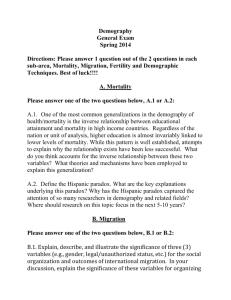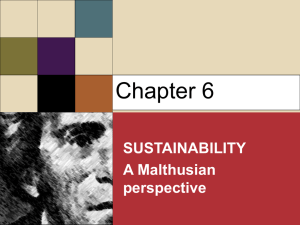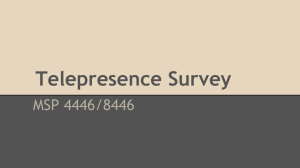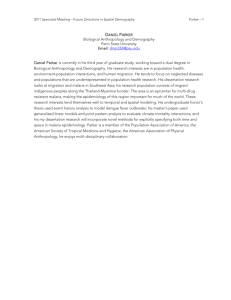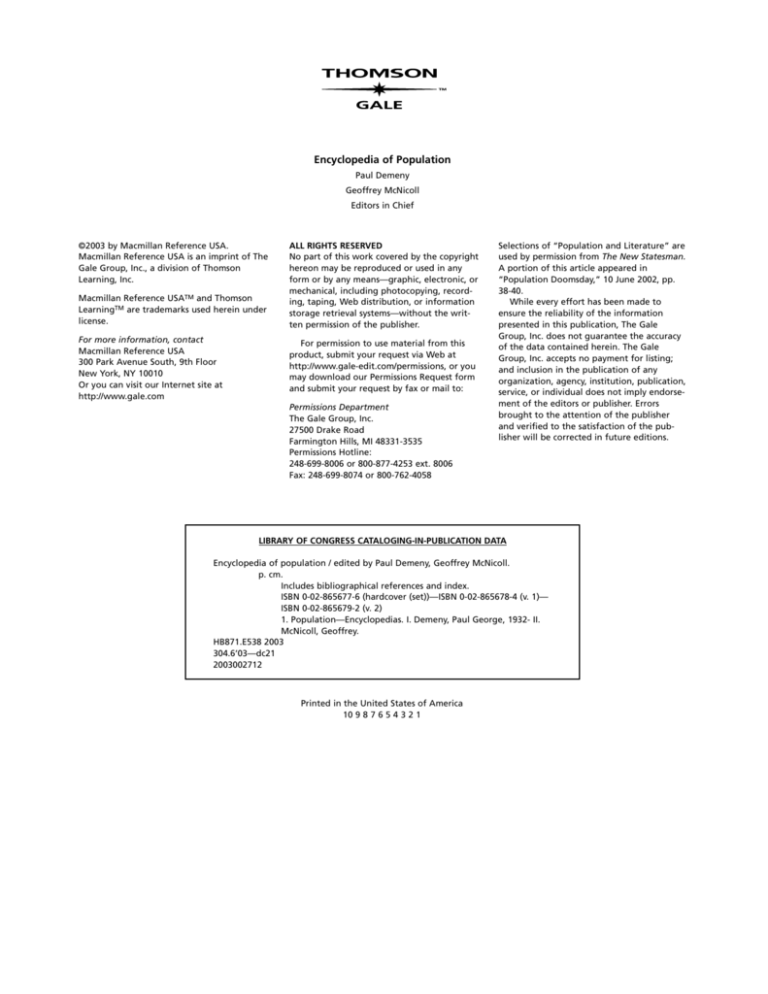
Encyclopedia of Population
Paul Demeny
Geoffrey McNicoll
Editors in Chief
©2003 by Macmillan Reference USA.
Macmillan Reference USA is an imprint of The
Gale Group, Inc., a division of Thomson
Learning, Inc.
Macmillan Reference USATM and Thomson
LearningTM are trademarks used herein under
license.
For more information, contact
Macmillan Reference USA
300 Park Avenue South, 9th Floor
New York, NY 10010
Or you can visit our Internet site at
http://www.gale.com
ALL RIGHTS RESERVED
No part of this work covered by the copyright
hereon may be reproduced or used in any
form or by any means—graphic, electronic, or
mechanical, including photocopying, recording, taping, Web distribution, or information
storage retrieval systems—without the written permission of the publisher.
For permission to use material from this
product, submit your request via Web at
http://www.gale-edit.com/permissions, or you
may download our Permissions Request form
and submit your request by fax or mail to:
Permissions Department
The Gale Group, Inc.
27500 Drake Road
Farmington Hills, MI 48331-3535
Permissions Hotline:
248-699-8006 or 800-877-4253 ext. 8006
Fax: 248-699-8074 or 800-762-4058
Selections of “Population and Literature” are
used by permission from The New Statesman.
A portion of this article appeared in
“Population Doomsday,” 10 June 2002, pp.
38-40.
While every effort has been made to
ensure the reliability of the information
presented in this publication, The Gale
Group, Inc. does not guarantee the accuracy
of the data contained herein. The Gale
Group, Inc. accepts no payment for listing;
and inclusion in the publication of any
organization, agency, institution, publication,
service, or individual does not imply endorsement of the editors or publisher. Errors
brought to the attention of the publisher
and verified to the satisfaction of the publisher will be corrected in future editions.
LIBRARY OF CONGRESS CATALOGING-IN-PUBLICATION DATA
Encyclopedia of population / edited by Paul Demeny, Geoffrey McNicoll.
p. cm.
Includes bibliographical references and index.
ISBN 0-02-865677-6 (hardcover (set))—ISBN 0-02-865678-4 (v. 1)—
ISBN 0-02-865679-2 (v. 2)
1. Population—Encyclopedias. I. Demeny, Paul George, 1932- II.
McNicoll, Geoffrey.
HB871.E538 2003
304.6’03—dc21
2003002712
Printed in the United States of America
10 9 8 7 6 5 4 3 2 1
EDITORIAL AND
PRODUCTION STAFF
Monica M. Hubbard, Project Editor
Nicole Watkins Project Assistant Editor
Shawn Beall, Mark Drouillard, Jan Klisz, Gloria Lam, Rebecca Marlow-Ferguson, Christine Mauer, Mark
Mikula, Kate Millson, Pamela Parkinson, Angela Pilchak, Christine Slovey, Jennifer Wisinski, Editorial Support
Mary Jane DeFrosia, Elizabeth B. Inserra, Christine Kelley, Eric Lowenkron, David E. Salamie, Copy Editors
John Krol, Proofreader
Laurie Andriot, Indexer
Tracey Rowans, Product Design Manager
Kate Scheible, Art Director
Datapage Technologies International, Inc. and GGS, Inc., Typesetters
Mary Beth Trimper, Manager, Composition
Evi Seoud, Assistant Manager, Composition
Rita Wimberley, Buyer
MACMILLAN REFERENCE USA
Frank Menchaca, Vice President
Jill Lectka, Director, Publishing Operations
vi
PREFACE
The core of population studies is the subject (to
many practitioners, the discipline) of demography
or demographic analysis, focusing on the quantitative dimensions of population change and its explanation—a subject that can readily extend beyond
human populations to other animate and even inanimate collectivities. Demographic analysis makes
substantial use of applied mathematics and statistical theory. The numbers that make up its feedstock
derive from longstanding government concerns with
recording “vital” events (births, marriages, deaths),
from the periodic complete enumeration of a country’s inhabitants through censuses of population,
and, in recent decades, from a large and elaborate
survey-taking industry.
Population as a field of study is concerned with the
membership of human groups and categories in all
their variety and with the processes of change in
membership. Interest in populations and population change can be found across a wide array of disciplines in the social and biological sciences—from
history and economics to epidemiology and genetics. In addition, population issues have numerous
political and ethical ramifications.
The Study of Population
The study of population has a history as old as the
study of society itself. Its origin as a distinct field,
however, is usually traced to the classical era of political economy and in particular to the writings of
Thomas Robert Malthus (usually T. R. Malthus,
sometimes Robert) in the late eighteenth and early
nineteenth centuries. Malthus’s prominent place
does not derive from his popular (largely unfounded) repute as an anti-populationist but rests on his
acute and wide-ranging empirical investigations of
comparative demographic regimes, exploring how
economic, social, and cultural circumstances influence demographic behavior and outcomes. Separate
precursors of the modern-day subject lie in the
“political arithmetic” of John Graunt and other
scholars a century before Malthus, out of which
came the systematic treatment of mortality through
life tables and actuarial analysis, and in the mathematics of population change and renewal, dating
from the eighteenth century. Additional, later, factors shaping the field came from the domain of public policy: social Darwinism and eugenics (an influence later to be regretted); hygiene and public
health; measures toward women’s emancipation;
and the discourse of human rights.
These threads of theory, analysis, and policy, in
various combinations, form the modern tapestry of
population studies. The emerging shape of the field
can be observed in the proceedings of the successive
quadrennial conferences of the International Union
for the Scientific Investigation of Population
Problems, an organization set up in the 1920s, and
its successor, the present-day International Union for
the Scientific Study of Population. Various entries in
this encyclopedia, notably those treating the history
of demography and population thought, offer a
fuller description of the evolution of the subject.
Surveys and Appraisals of the Population
Field
The first formal stocktaking of the field of population was the volume Traité de démographie, by
Adolphe Landry and collaborators (Paris, 1945).
This important and pioneering treatise was never
translated into English. Alfred Sauvy, one of Landry’s
co-authors, published his two-volume Théorie
vii
viii PREFACE
générale de la population (Paris: Presses universitaires
de France) in 1952 and 1954—a study whose ambition was signified by the Keynesian echoes of its title.
(A one-volume English translation, General Theory
of Population, appeared in 1969.) For an Englishspeaking readership the first large-scale overview of
the field was The Study of Population: An Inventory
and Appraisal, edited by Philip M. Hauser and Otis
Dudley Duncan (Chicago: University of Chicago
Press, 1959)—a large and impressive work that still
repays reading. In some 30 chapters, well-known
scholars surveyed the elements of demography, the
status of demographic research in major countries,
and the place of demography in the various more
established social science disciplines.
The scope of demography—concepts, the institutional makeup of the field, and a who’s who of
demographers—was laid out by William Petersen
and Renee Petersen in their 1985 Dictionary of
Demography. Around the same time, the first specialized encyclopedia on the subject, the International
Encyclopedia of Population, edited by John A. Ross,
was issued (New York: The Free Press, 1982). More
recently, a number of assessments of the field of population have been occasioned by anniversaries.
Special journal issues comprising articles that survey
the state of demographic research appeared on the
50th anniversary of Population (the journal of the
Institut national d’études démographiques, Paris) in
November-December 1995, and of Population
Studies (Population Investigation Committee,
London School of Economics) in November 1996;
and on the 30th anniversary of Demography (the
journal of the Population Association of America) in
November 1993.
Population matters have some place in each of
the three multi-volume encyclopedias of the social
sciences—published in 1930–1935, 1968, and
2001—although perhaps limited by demography’s
uncertain status as a discipline. (The 2001 encyclopedia accepted it as “possessing a kind of disciplinary
integrity.”) Various specialized encyclopedias—on
aging, bioethics, economics, the environment, and so
on—necessarily also give appreciable space to population. In economics, what was once a strong interest
in population slowly waned over the course of the
twentieth century, typified by the drop from two full
chapters on the subject in F. W. Taussig’s Principles of
Economics (1911), the standard university text of the
early decades of the century, to a few passing paragraphs in Gregory Mankiw’s 1998 Principles. Much
of the modest population content of The New
Palgrave (1987), a current encyclopedic authority on
economics, is concerned with the microeconomics of
the family.
The Encyclopedia of Population
What is the need for an encyclopedia of population
at this time? One answer would be that the world’s
population growth is far from over, with continuing
and far-reaching effects on human society and the
natural environment. Even though birth rates have
declined quite steeply across much of the world,
another two billion people are expected to be added
to the existing six billion in the period 2000–2030—
almost as many as were added in 1970–2000, the
peak period of the “population explosion.” Large
regions of the world are still characterized by pervasive poverty, poor health conditions, and intractable
problems of development—each with significant
demographic dimensions.
But the main reason this encyclopedia is called
for is the enlargement of the scope of the subject. In
the 1980s, population issues seemed to many people
to connote little else but rapid population growth and
measures to curtail it. Today, population growth is
one concern among many. Even a partial listing suggests the breadth of this expanded range of interest:
the entrenchment of very low fertility and the growing problems of old-age support; the retreat from
marriage and the diversification of family forms; new
medical technologies affecting reproduction and
longevity; the AIDS epidemic and the resurgence of a
number of other infectious diseases; increased SouthNorth migration and refugee movements; the press
for women’s equality and fuller reproductive rights; a
widened array of environmental effects, notably climate change; and global shifts in the relative population sizes of countries. The evolutionary bases of
human development and behavior have received
renewed attention, with insights drawn from radical
advances in genomic research and from comparisons
with other species. Many of these topics have ethical
debates associated with them—longstanding, like
abortion and asylum-seeking, or newfound, like
genetic engineering and animal rights. Along with
such contemporary issues, research on population
history and prehistory has proceeded apace, settling
some controversies and raising others. All this is territory staked out by the Encyclopedia of Population.
The Encyclopedia of Population is directed both
to professionals in the population sciences reading
outside their immediate areas of expertise and to
PREFACE
other social scientists, college students, advanced
high school students, and the educated lay reader.
Catering to this range of readership is challenging.
An effort is made to avoid material and jargon that
would require prior specialized knowledge, but without losing significant detail through undue simplification. (Characterizations of persons named in the
text of articles by their nationality or profession are
included for the same reason, even when such information would be well known to many users.) Where
a topic requires technical treatment, it receives it, or
the reader is referred to appropriate further sources.
However, the Encyclopedia is not intended to serve
as a textbook on its field. If it has an ambition
beyond the utilitarian it is to push out the boundaries of the subject—an ambition that stands in contrast to that implicitly set by the Population
Association of America, whose journal prominently
defines its scope as being “the statistical study of
human populations.”
Not a few topics in population studies are contentious, either in terms of research findings or, more
basically, in terms of their political and ethical premises or implications. Unsurprisingly, the various
authors writing on matters related to such topics may
often take differing positions. We have not sought to
suppress those differences, but rather to ensure a
rough overall degree of balance among the articles.
The Encyclopedia contains 336 articles by a total
of 278 authors. The contributors are all accomplished scholars, their expertise spanning a wide
range of fields: biology, demography, economics,
geography, history, law, philosophy, political science,
public health, sociology. Many of the articles are
short entries of 500–1000 words of text; only a relatively few are longer than 3000 words. Within this
range, length is roughly dictated by the scope of the
topic; the level of technicality is governed by what is
required to explain it.
Among the short entries are 60 biographies of
persons selected from those whose work has been
important in the development of population studies,
whether or not they were seen (or saw themselves) as
“population” people. Compiling such a list entails
many somewhat arbitrary choices and no two lists
would be the same. In the present case, contributors
to technical demography will be less in evidence in
the encyclopedia than persons whose work has been
influential in the development of population
thought more broadly. Invidious choice among
ix
presently active scholars has been avoided by including only persons born in or before 1930, or deceased.
A thematic overview of the Encyclopedia of
Population is given in the Topical Outline, which follows the List of Authors in the frontmatter . The
Outline may be particularly helpful to students who
wish to find population-related information relevant
to their studies in other fields but who do not have in
mind a particular topical entry. A student in environmental studies, for example, could narrow his or
her search within the sixteen articles listed under the
heading Environment and Resources; a political science student might scan the eleven articles listed
under Political Demography, and perhaps also the
ten under Population Policy.
The Population Tables at the end of the second
volume presents four summary tables showing statistics on population size, rates of change, area, and
density, by country, for countries of 10 million population and over. (These countries contain over 90%
of the world’s population.)
We hope readers of the Encyclopedia will find in
it much material that is new to them. A test of such a
work, in addition to its reference function, is the
extent to which it repays browsing and offers the
casual serendipitous discovery or insight. Inevitably,
occasional gaps in coverage will be found. Some of
these may reflect particular editorial decisions; others result from nondelivery of promised articles (the
proportion of such defaults, some 7%, is relatively
low for enterprises such as this). We would hope, like
the editors of The New Palgrave (p. x), that “such
errors of omission and commission . . . are unbiased,
in almost every sense of the word.”
Our main acknowledgment is of the encyclopedia’s contributors, for their work and sometimes for
their forbearance of editorial intrusiveness.
Assistance from members of the committee of
Editorial Advisors is also much appreciated. At
Macmillan Reference, Jill Lectka, Monica Hubbard,
and Nicole Watkins were efficient and congenial
counterparts; to them also should go credit for ensuring that the project kept not too far behind its schedule. At the Population Council, Robert Colasacco
provided administrative and secretarial assistance.
The overall institutional support of the Population
Council was an essential factor in the undertaking.
PAUL DEMENY
GEOFFREY MCNICOLL
NEW YORK, MARCH 2003
TOPICAL OUTLINE
The classification of articles that follows provides a thematic view of the encyclopedia’s contents,
depicting overall coverage in the various familiar divisions of the field of population studies. It is
also intended to assist the user, whether researcher or browser, in locating articles broadly related
to a given topic. This purpose would be defeated if articles that clearly belong under more than one
category were listed only once. For example, Sex Selection might be sought under either Ethical
Issues or Reproduction and Birth Control. To prevent the listing from becoming too large, however, only articles where the case for multiple entry is compelling (about one in six) are so treated.
Where two categories are closely related, such as Mortality and Health on the one hand and Disease
and Disability on the other, articles appear in only one of them. A more detailed means of finding
cognate material is through the list of cross-references shown after each article. For finer-grained
access to the encyclopedia’s contents, the index should be consulted.
Biographies are not included among the articles listed in the substantive classification. They appear
in the subsequent list, ordered by date of birth and grouped by the century in which the subject’s
main work was done.
I. THE POPULATION FIELD, POPULATION
THEORY, AND POPULATION HISTORY
Fertility Transition, Socioeconomic
Determinants of
Health Transition
A. THE POPULATION FIELD
Homeostasis
Bibliographic and Online Resources
Human Ecology
Conferences, International Population
Migration Models
Demography, History of
Momentum of Population Growth
Journals, Population
Optimum Population
Population
Organizations, Demography of
Population Thought, Contemporary
Population Thought, Contemporary
Population Thought, History of
Population Thought, History of
B. POPULATION THEORY
Second Demographic Transition
Action Theory in Population Research
Sociobiology
Animal Ecology
C. APPLIED DEMOGRAPHY
Demographic Transition
Diffusion in Population Theory
Business Demography
Epidemiological Transition
Small-Area Analysis
Evolutionary Demography
State and Local Government Demography
xxxiii
xxxiv TOPICAL OUTLINE
D. POPULATION ORGANIZATIONS
Population Organizations: National and
International Agencies
Population Organizations: Professional
Associations
Population Organizations: Research Institutions
Population Organizations: United Nations
System
E. PREHISTORIC DEMOGRAPHY
Archaeogenetics
Paleodemography
Peopling of the Continents
Prehistoric Populations: Africa
Prehistoric Populations: Asia
Prehistoric Populations: Australia and the
Pacific
Prehistoric Populations: Europe
Prehistoric Populations: The Americas
F. HISTORICAL DEMOGRAPHY
African-American Population History
Ancient World, Demography of
Black Death
Cities, Demographic History of
Disease, Concepts and Classification of
Disease and History
Epidemics
Family: History
Health Transition
Historical Demography
Household Composition
Induced Abortion: History
Infanticide
Mortality Decline
Peopling of the Continents
Population Thought, History of
Slavery, Demography of
Trans-Atlantic Migration
II. DEMOGRAPHIC DATA, TECHNIQUES, AND
MODELS
A. POPULATION STATISTICS AND DATA
COLLECTION
Anthropometry
Bibliographic and Online Resources
Census
Databases, Demographic
Demographic and Health Surveys
Demographic Surveillance Systems
Demographic Surveys, History and
Methodology of
Genealogical Records
Longitudinal Demographic Surveys
Population Registers
Vital Statistics
World Fertility Survey
B. DEMOGRAPHIC TECHNIQUES
Actuarial Analysis
Age Measurement
Archaeogenetics
Cohort Analysis
Data Assessment
Estimation Methods, Demographic
Event-History Analysis
Family Reconstitution
Fertility Control, Indirect Measurement of
Fertility Measurement
Lexis Diagram
Life Course Analysis
Life Tables
Mortality Measurement
Paleodemography
Population Dynamics
Projections and Forecasts, Population
Remote Sensing
Risk
C. MATHEMATICAL DEMOGRAPHY
Animal Ecology
Artificial Social Life
Life Tables
Multistate Demography
Renewal Theory and the Stable Population
Model
Simulation Models
Stochastic Population Theory
III. DEMOGRAPHIC PROCESSES, STRUCTURE,
AND BEHAVIOR
A. FERTILITY
Adolescent Fertility
Baby Boom, Post-World War II
Childlessness
TOPICAL OUTLINE
Family Size Intentions
Fertility, Age Patterns of
Fertility, Below-Replacement
Fertility, Nonmarital
Fertility, Proximate Determinants of
Gender Preference for Children
Mortality-Fertility Relationships
Multiple Births
Second Demographic Transition
Sex Ratio
Unwanted Fertility
B. REPRODUCTION AND BIRTH CONTROL
Abstinence
Birth Control, History of
Contraception, Modern Methods of
Contraceptive Prevalence
Family Planning Programs
Fecundity
Fertility, Proximate Determinants of
Genetic Testing
Induced Abortion: History
Induced Abortion: Legal Aspects
Induced Abortion: Prevalence
Infertility
Natural Fertility
Reproductive Health
Reproductive Technologies: Modern Methods
Sex Selection
Spontaneous Abortion
C. POPULATION BIOLOGY
Aging and Longevity, Biology of
Animal Ecology
Biodemography
Biology, Population
Evolutionary Demography
Mortality Differentials, by Sex
Primate Demography
Sex Ratio
D. MARRIAGE AND FAMILY
Adoption
Childlessness
Cohabitation
Divorce
Family: Future
Family: History
Family Demography
Family Life Cycle
Family Size Distribution
Grandparenthood
Marriage
Parenthood
Partner Choice
Sexuality, Human
E. MORTALITY AND HEALTH
Aging and Longevity, Biology of
Biodemography
Causes of Death
Disasters
Environmental Health
Epidemics
Epidemiological Transition
Extinction, Human
Famine, Concepts and Causes of
Famine in Africa
Famine in China
Famine in Ireland
Famine in South Asia
Famine in Soviet Union
Genocide
Health Systems
Health Transition
Holocaust
Infant and Child Mortality
Infanticide
Life Span
Life Tables
Maternal Mortality
Mortality, Age Patterns of
Mortality Decline
Mortality Differentials, by Sex
Mortality Differentials, Socioeconomic
Mortality Reversals
Oldest Old
Reproductive Health
War, Demographic Consequences of
F. DISEASE AND DISABILITY
Accidents
AIDS
Alcohol, Health Effects of
xxxv
xxxvi TOPICAL OUTLINE
Black Death
Cancer
Cardiovascular Disease
Disability, Demography of
Disease, Burden of
Disease, Concepts and Classification
Disease and History
Diseases, Chronic and Degenerative
Diseases, Infectious
Emerging Infectious Diseases
Epidemics
Homicide and Suicide
Influenza
Tobacco-Related Mortality
Tuberculosis
G. MIGRATION
Forced Migration
Immigration, Unauthorized
Immigration Trends in Major Destination
Countries
Internal Migration
International Migration
Labor Migration, International
Outer Space, Colonization of
Peopling of the Continents
Refugees, Demography of
Resettlement
Temporary Migration
Trans-Atlantic Migration
H. SUBGROUP POPULATIONS
African-American Population History
Caste
Chinese, Overseas
Ethnic and National Groups
Hunter-Gatherers
Indigenous Peoples
Languages and Speech Communities
Nomads
Oldest Old
Racial and Ethnic Composition
Religious Affiliation
Slavery, Demography of
I. POPULATION STRUCTURE AND TRENDS
Age Structure and Dependency
Aging of Population
Baby Boom, Post-World War II
Cities, Future of
Demographic Transition
Density and Distribution, Population
Family: Future
Family Demography
Family Size Distribution
Fertility, Below-Replacement
Homeostasis
Household Composition
Immigration Trends in Major Destination
Countries
Momentum of Population Growth
Mortality Decline
Mortality Reversals
Occupation and Industry
Population Decline
Projections and Forecasts, Population
Residential Segregation
Rural-Urban Balance
Suburbanization
Urbanization
World Population Growth
IV. SPATIAL, ECONOMIC, AND
ENVIRONMENTAL ASPECTS OF
POPULATION
A. GEOGRAPHY OF POPULATION
Biogeography
Central Place Theory
Density and Distribution, Population
Geographic Information Systems
Geography, Population
Microstates, Demography of
B. URBAN DEMOGRAPHY
Cities, Demographic History of
Cities, Future of
Cities, Systems of
Residential Segregation
Rural-Urban Balance
Suburbanization
Urbanization
C. ECONOMIC DEMOGRAPHY
Common Property Resources
TOPICAL OUTLINE
Cost of Children
Cycles, Population
Development, Population and
Dietary Regimes
Economic-Demographic Models
Externalities of Population Change
Family Bargaining
Famine, Concepts and Causes of
Generational Accounting
Immigration, Benefits and Costs of
Intergenerational Transfers
Labor Force
Labor Migration, International
Microeconomics of Demographic Behavior
Migration Models
Nutrition and Calorie Consumption
Occupation and Industry
Poverty and Income Distribution
Risk
Value of Life, Economic
D. ENVIRONMENT AND RESOURCES
Biogeography
Carrying Capacity
Climate Change and Population: Future
Climate Change and Population: History
Deforestation
Ecological Perspectives on Population
Energy and Population
Environmental Health
Environmental Impact, Human
Food Supply and Population
Land Use
Limits to Growth
Natural Resources and Population
Nitrogen Cycle
Sustainable Development
Water and Population
V. CULTURAL AND POLITICAL ASPECTS OF
POPULATION
A. SOCIETY AND CULTURE
Anthropological Demography
Crime, Demography of
Culture and Population
Education
xxxvii
Gender
Human Ecology
Literacy
Literature, Population in
Mass Media and Demographic Behavior
Public Opinion on Population Issues
Social Capital
Social Institutions
Social Mobility
Social Networks
Social Reproduction
Technological Change and Population Growth
Values and Demographic Behavior
Women’s Status and Demographic Behavior
B. ETHICS AND POPULATION
Animal Rights
Data Collection, Ethical Issues in
Environmental Ethics
Euthanasia
Future Generations, Obligations to
Genetic Testing
Quality of Population
Religions, Population Doctrines of
Reproductive Rights
Reproductive Technologies: Ethical Issues
Sex Selection
C. POLITICAL DEMOGRAPHY
Communism, Population Aspects of
Ethnic Cleansing
Feminist Perspectives on Population Issues
Forced Migration
Genocide
Geopolitics
Holocaust
Lebensraum
National Security and Population
States System, Demographic History of
War, Demographic Consequences of
D. POPULATION POLICY
Asylum, Right of
Eugenics
Family Allowances
Family Planning Programs
Family Policy
xxxviii TOPICAL OUTLINE
Immigration Policies
F. NINETEENTH-TWENTIETH CENTURY
One-Child Policy
Edwin Cannan
Population Policy
Werner Sombart
Sex Ratio
Welfare State
VI. BIOGRAPHIES
G. TWENTIETH CENTURY
Adolphe Landry
R. R. Kuczynski
Raymond Pearl
A. SIXTEENTH CENTURY
Giovanni Botero
B. SEVENTEENTH CENTURY
John Graunt
William Petty
Gregory King
Alfred J. Lotka
John Maynard Keynes
Margaret Sanger
Corrado Gini
Warren S. Thompson
P. K. Whelpton
Alfred Sauvy
C. EIGHTEENTH CENTURY
Dorothy Swaine Thomas
Richard Cantillon
Simon Kuznets
Leonhard Euler
Frank W. Notestein
Johann Süssmilch
August Lösch
Marquis de Condorcet
Irene B. Taeuber
Jean-Baptiste Moheau
Kingsley Davis
D. EIGHTEENTH-NINETEENTH CENTURY
William Godwin
T. R. Malthus
E. NINETEENTH CENTURY
Ester Boserup
David Glass
Louis Henry
Bernard Berelson
Nathan Keyfitz
Benjamin Gompertz
Philippe Ariès
Adolphe Quetelet
Garrett Hardin
Pierre-François Verhulst
Peter Laslett
John Stuart Mill
Ansley Johnson Coale
William Farr
Ronald Freedman
Charles Darwin
William Brass
Karl Marx
Harvey Leibenstein
Francis Galton
Norman B. Ryder
József Kőrösi
Judith Blake
Vilfredo Pareto
Richard A. Easterlin
Arsène Dumont
John C. Caldwell
Jacques Bertillon
Gary S. Becker
Knut Wicksell
Julian L. Simon

